The AMD Trinity Review (A10-4600M): A New Hope
by Jarred Walton on May 15, 2012 12:00 AM ESTAMD Trinity Gaming Performance
After the 3DMark results, you might be wondering if Intel has finally caught up to AMD in terms of integrated graphics performance. The answer is…yes and no. Depending on the game, there are times where a fast Ivy Bridge CPU with HD 4000 will actually beat out Trinity; there are also times where Intel’s IGP really struggles to keep pace. The good news is that at least everyone is now onboard the DX11 bandwagon, and compatibility with games has improved yet again for Intel. Here are our “Value” benchmark results for seven recent games; we’ll have more information in a moment.

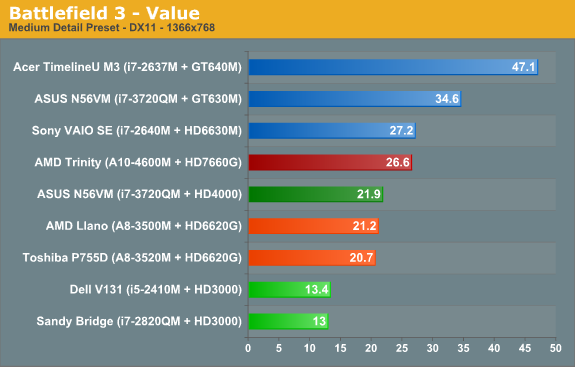
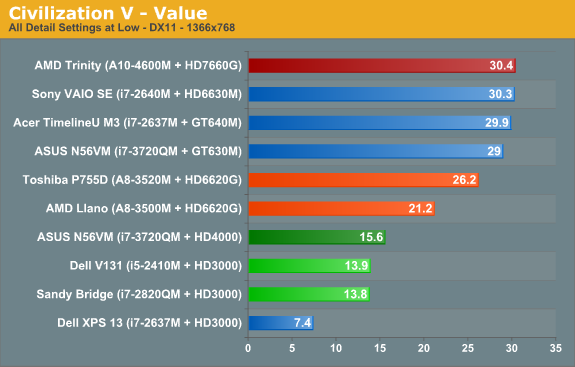

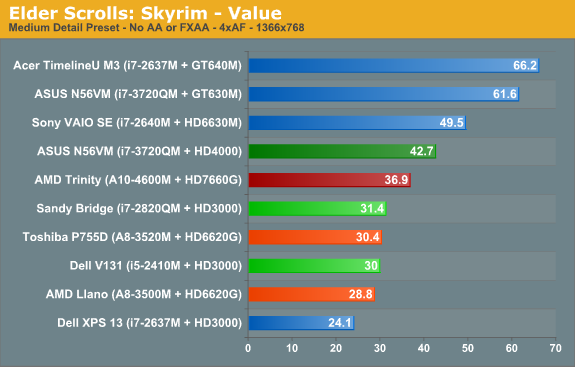
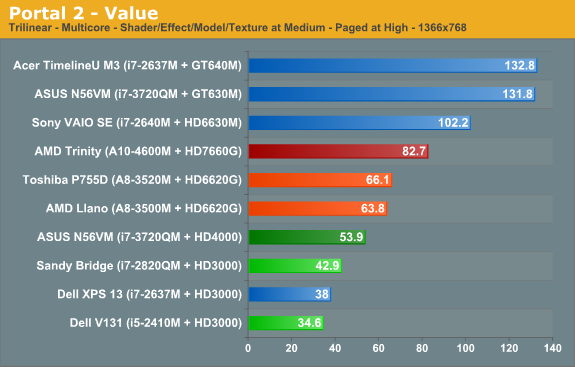
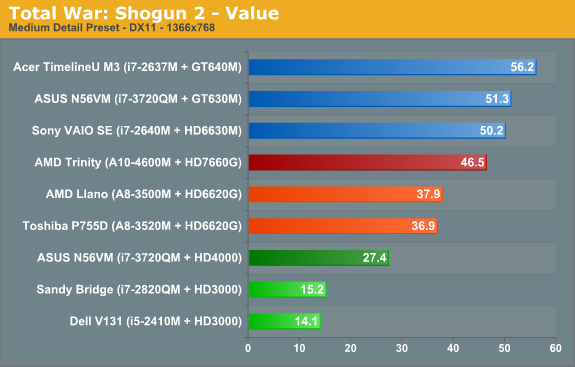
Out of our seven test titles, AMD’s Trinity leads any other IGP in four titles by a large margin. The other three titles actually have Ivy Bridge slightly ahead of Trinity, but the gaps aren’t nearly as big. Overall, the average performance across the seven games at our Value (medium) settings has AMD’s Trinity A10-4600M leading Intel’s i7-3720QM by 21%, and if we look at quad-core Sandy Bridge with HD 3000 (i7-2820QM) Trinity is 72% faster. Trinity is also around 20% faster than 35W Llano on average.
Let’s expand our gaming suite just a bit to see if things change, though. Just like we did with Ivy Bridge, we ran the eight games in our previous benchmark suite at medium detail settings. We can then compare performance across a wider 15 title selection to see how Trinity matches up against HD 4000, HD 3000, and HD 6620G (Llano). We’ll start with the bottom (HD 3000/Sandy Bridge) and move up.
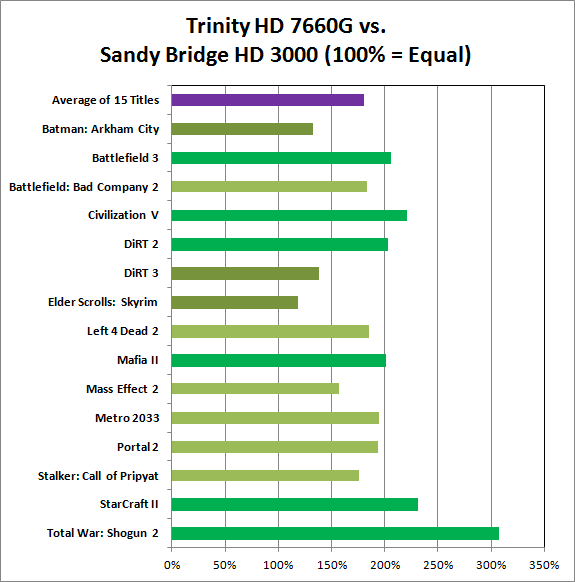
Llano’s HD 6620G was already faster than HD 3000, and Trinity’s HD 7660G is faster than Llano, so the Sandy Bridge gaming matchup is a landslide victory in AMD’s favor. The closest Intel can get is in the same three titles where Ivy Bridge leads Trinity: Batman: Arkham City, DiRT 3, and Skyrim. Here, however, HD 3000 can’t actually close the gap and HD 6620G is at least 20% faster than HD 3000, with an average performance improvement of nearly 80%.
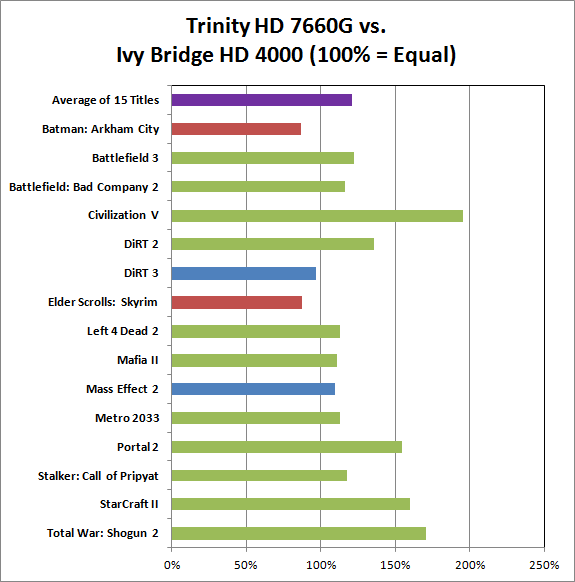
We found that across the same selection of 15 titles, Ivy Bridge and Llano actually ended up “tied”—Intel led in some games, AMD in others, but on average the two IGPs offered similar performance. This chart and the next chart will thus show a similar average increase in performance for Trinity, but the details in specific games are going to be different. Starting with Ivy Bridge and HD 4000, as with our earlier game charts we see there are some titles where Intel leads (Batman and Skyrim), a couple ties (DiRT 3 and Mass Effect 2), and the remainder of the games are faster on Trinity. Mafia II is close to our <10% “tie” range but comes in just above that mark, as do Left 4 Dead 2 and Metro 2033. The biggest gap is Civilization V, where Intel’s various IGPs have never managed good performance; Trinity is nearly twice as fast as Ivy Bridge in that title. Overall, it's a 20% lead for Trinity vs. quad-core Ivy Bridge.
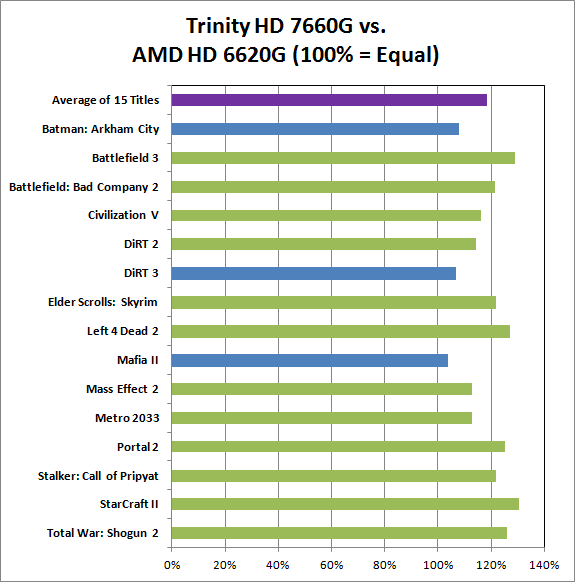
Against Llano, Trinity is universally faster, but the smallest gap is in Mafia II (3%) while the largest gap is in StarCraft II (30%). On average, looking at these games Trinity is only 18% faster than Llano. What’s not entirely clear from the above chart is whether we’re hitting CPU limitations, memory bandwidth limitations (remember that Llano and Trinity share bandwidth with the rest of the system), or perhaps both. At our chosen settings, what is clear is that Trinity’s “up to 56% faster” graphics never make it that high.
We saw 35-45% higher scores in 3DMark 11 and Vantage, which tend to remove the CPU from the equation more than actual games, so our guess would be that if AMD continues with their APU plan they’re going to need to work more on the CPU side of the equation. We also see the same thing looking at the VAIO SE scores in the earlier gaming charts: the HD 6630M scores are 20% faster on average, but much of that appears to come from the faster CPU rather than the GPU.










271 Comments
View All Comments
Spunjji - Wednesday, May 16, 2012 - link
Go away, please.silverblue - Thursday, May 17, 2012 - link
Can you and sans2212 go into a room and fight it out, please? One of you hates AMD, the other wants its babies, and I've a sneaky suspicion that, like matter and antimatter, you might actually cancel each other out.(they also both cease to exist, but I thought that'd be a bit cruel)
e36Jeff - Tuesday, May 15, 2012 - link
oh well, thanks for checking, and thanks for the reply. I guess I'll just have to wait for you guys to get your hands on an actual LV/ULV trinity chip.plonk420 - Tuesday, May 15, 2012 - link
is the Dell V131 tested 2, 4, or 6gb? (i.e. single or dual channel) and how about the other laptops?JarredWalton - Tuesday, May 15, 2012 - link
I actually stuck in 2x4GB DDR3-1600 from the IVY system to make things "equal". Sorry for not noting that. I did the same for Llano, Trinity, and QC SNB. Same SSD, same RAM -- though Llano and SNB ran the RAM at DDR3-1333.Iketh - Tuesday, May 15, 2012 - link
Awesome article Jarred!I caught only one mistake...
"Power consumption is also improved over Llano, making Trinity is a win across the board for AMD compared to its predecessor."
SuperVeloce - Tuesday, May 15, 2012 - link
"Llano was already faster in general use than Core 2 Duo and Athlon X2 class hardware."This is so wrong, it's beggar belief. Just for comparison, my old C2D T8300 (2,4ghz, 3mb L2) is actually faster than A4-3300 overclocked to 2,8ghz in every task and benchmark i throw at them. Even at 2,6ghz it's only on par with T7500 (2,2ghz, 4mb L2, year 2006 my friends).
Well yes, I guess A4 (not overclocked) is less power-hungry and can do quite a bit of undervolting but you see my point... liano is slower than equivalent mobile c2d, if Open-CL from gpu is not in use.
JarredWalton - Tuesday, May 15, 2012 - link
Care to provide some specific benchmarks that prove this out? Because by my numbers, it doesn't look that way:http://www.anandtech.com/show/2585/6
I didn't post Cinebench 10 in the article, but Trinity scores 2834 single-threaded and 8222 multi-threaded. That makes the single-threaded score basically tied with the Core 2 Duo X7900 (2.8GHz) and the multi-threaded score is 50% faster. Llano on the other hand scores 2037 and 6824 in the same tests -- slightly slower than P8400 on single threads but faster on multi-threaded.
PCMark 05 I can provide results for as well, though the SSD certainly skews things on Trinity. Trinity = 10824, Llano (HDD) = 6236, P8400 = 6561 (close enough to Llano), and X7900 = 7544. But I'm not talking specific tasks; I simply said "faster in general use" -- depending on which version of Llano you're talking about. The fastest Core 2 vs. the slowest A8 would probably be a tossup on the CPU side.
eanazag - Tuesday, May 15, 2012 - link
I am disappointed that the desktop versions are not available till Q3. I was thinking this would replace my Core i3 540 at home soon.PolarisOrbit - Tuesday, May 15, 2012 - link
I am wondering if there is a better way to communicate value other than pricing because throughout the article the reviewer estimates Trinity at $600, while in the comments to readers the same reviewer's estimates vary from $700-$800.What is to be made of this discrepency? I am wondering if it wouldn't be better to just avoid price predictions altogether. Surely there is some other way of describing relative value. Maybe estimates of what other setups would have similar performance is enough by itself.